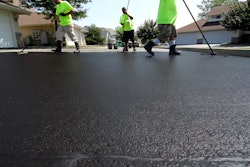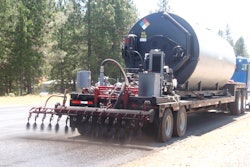At the end of its 2013 session, the Minnesota State Legislature passed a catch-all appropriations bill to fund various environmental projects. Included in the 55-page bill was a half-page section (Chapter 137, Sec. 17, 116.202) that banned the use and sale of refined coal tar-based pavement sealers (RTS) in Minnesota beginning January 1, 2014. There were no hearings and the ban did not receive much attention during the regular legislative session – it was added by the conference committee (a committee that merges bills passed in the House and Senate, resolving differences to produce a single, final law) at the request of the governor’s office, the Minnesota Pollution Prevention Agency (MPCA) and the Minnesota League of Cities.
The statewide ban resolved the MPCA-inflicted problem of a patchwork of local bans that resulted from an earlier law that allowed the agency to award funds to local governments if the municipality banned RTS. But how did MPCA adopt that policy and why did the agency remain so dedicated to banning a product that had been safely used for decades by many Minnesota businesses and consumers? The story tells itself in emails obtained via Minnesota’s version of the Freedom of Information Act. The next few columns will be devoted to telling the story – a tale that mixes bad science with unnecessarily burdensome regulation, misspent taxpayer dollars, and politicians led by federal and state employees with misguided policy preferences. Taken together, what transpired in Minnesota is a textbook case of what is, in the scientific literature, called White Hat Bias - “bias leading to the distortion of information in the service of what may be perceived to be righteous ends.”
The story begins in an email exchange dated April 1, 2008 between MPCA staff scientist Kieth Cherryholmes and Professor Robert Pitt, a storm water engineering expert at the University of Alabama. Cherryholmes’ email describes the problem:
We have run into a situation in a city in the Twin Cities metro area that had sediment from a wet detention pond analyzed for a suite of contaminants and found the PAHs to be very high. …We were curious if you had done any research on wet detention pond sediment that had high concentrations of PAHs and where they might be coming from in residential neighborhoods. We thought perhaps that the parking lot and driveway sealants. Some sealants are derived from coal tar….
PAHs are common everywhere in highly trafficked urban areas, and, as will be seen as the story progresses, MPCA’s idea of “very high” concentrations of PAHs suggests that the staff had not yet done much research into the distribution of PAHs in the U.S. But they had heard about the US Geological Survey (USGS) study in Austin, Texas. Professor Pitt had heard about the Austin study too. He responds as follows:
oh my. this is a problem. The City of Austin has outlawed cold [sic] tar sealants just to prevent this problem. They were finding very high PAHs in creek sediments and their source area testing identified the sealers as being the culprit….
Those of us involved in sealcoating can, today, recognize the problems with Dr. Pitt’s description of the Austin study. Austin did NOT find “very high PAHs in creek sediments” and the USGS did NOT do any source area testing. We now have the data to show that RTS was not identifiable as a source of PAHs in Austin creek sediments either before or after the ban on RTS. Even at the time, however, Dr. Pitt and MPCA could have known that the U.S. EPA and the Texas Commission on Environmental Quality and the Texas Department of Health had all concluded that PAHs in Austin creek sediments were below any concentration that could pose a threat to either people or wildlife.
In an email exchange among MPCA staff dated November 26, 2008, the decision was made to “work towards supporting a ban on coal-tar based sealants in Minnesota. What happened between April and November to lead MPCA to decide to seek to ban a useful, non-hazardous product that is the backbone of hundreds of small businesses in the upper Midwest? That will be explored in the next column.




















